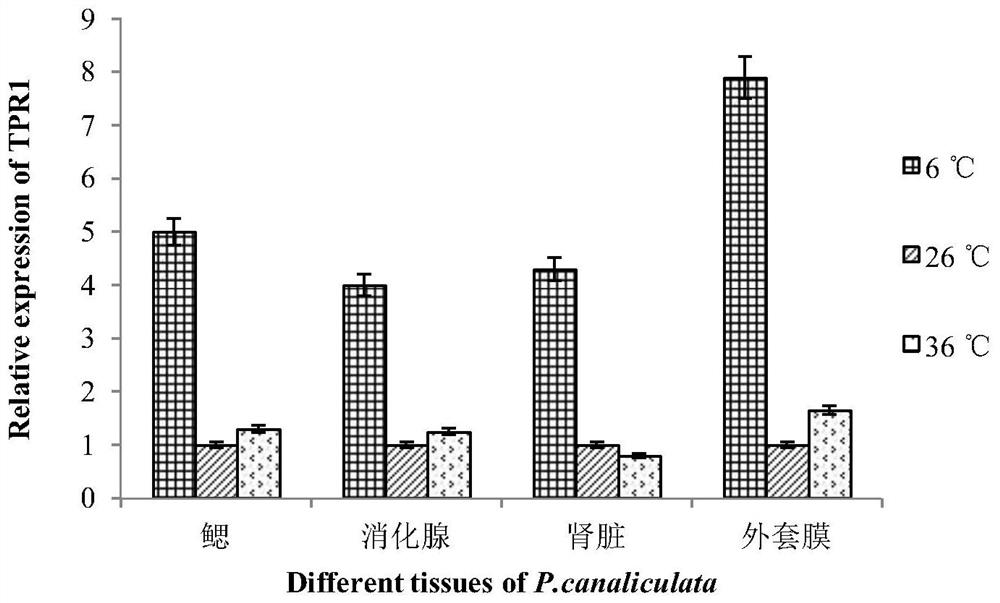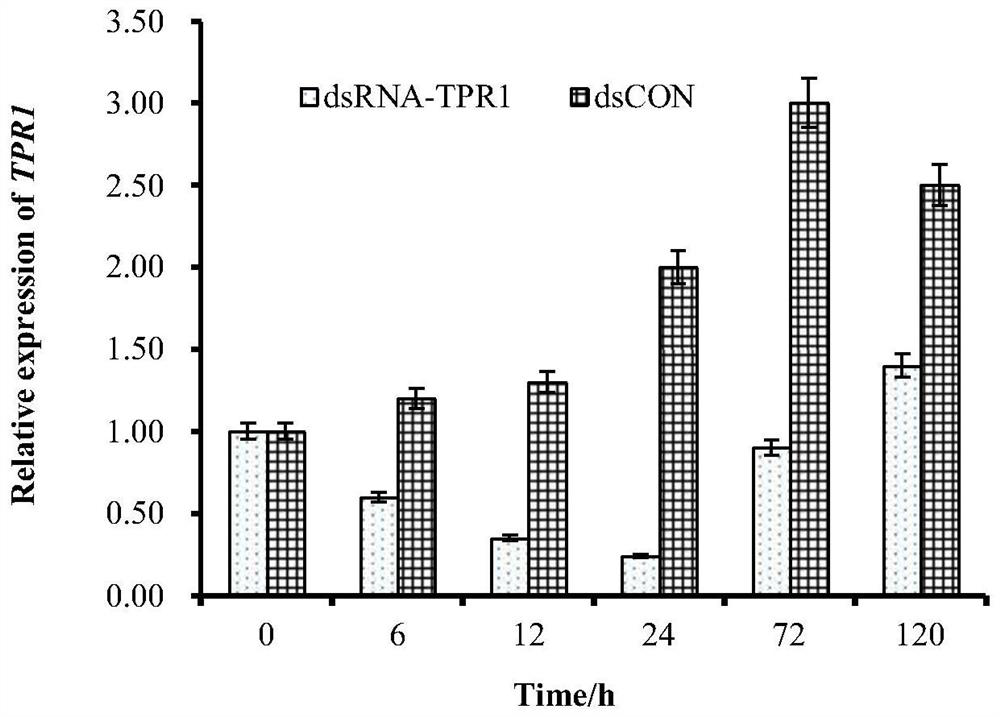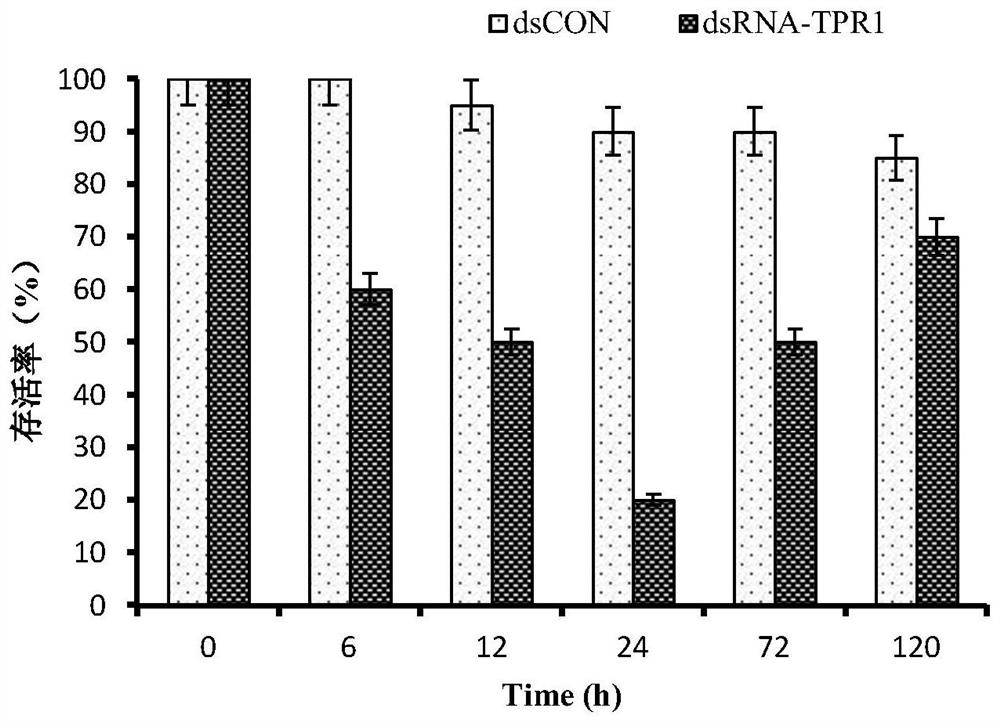TPR1 gene related to low-temperature tolerance of ampullaria gigas, encoded protein and application of TPR1 gene
A low-temperature tolerance and protein-coding technology, applied in the field of coding protein, TPR1 gene, can solve the problems of unrelated research reports on functions and effects, and achieve the effects of prolonging the incubation period, improving control efficiency, and strong repeatability
- Summary
- Abstract
- Description
- Claims
- Application Information
AI Technical Summary
Problems solved by technology
Method used
Image
Examples
Embodiment 1
[0021] 1 Materials and methods
[0022] 1.1 Apple snails tested
[0023] The selected apple snails are young snails with a height of 5.0-10.5mm. Before the experiment, all individual apple snails were raised in tanks (40cm×25cm×28) in a constant temperature laboratory. 8h, the feed is fresh cabbage leaves.
[0024] 1.2 Main reagents
[0025] akaraMiniBest Universal RNA Extraction Kit (TakaRa), TakaRaMiniBESTAgarose Gel DNA Extraction Kit, Taq enzyme, SYBR Premix Ex Taq, RACE Kit User Manual were purchased from Clontech Company in the United States, and sequencing and primer synthesis were completed by Shanghai Sunny Bio-Express Co., Ltd.
[0026] Cloning of TPR1 gene of apple snail
[0027] 1) Take 10mg-50mg of apple snail mantle tissue, rinse with DEPC water 3-5 times, and store in liquid nitrogen;
[0028] 2) Extraction of total RNA: Grind the mantle tissue of the apple snail into powder under liquid nitrogen conditions, and then use TakaraMiniBest Universal RNA Extracti...
Embodiment 2
[0045] Example 2. Analysis of TPR1 expression in different tissues under different temperature stresses
[0046] Total RNA was extracted from different tissues, and the tissue expression of TPR1 gene under different temperature stress was detected by qPCR. The reaction volume is 25 μL. The reaction program was: pre-denaturation at 95°C for 1min; then 35 cycles at 95°C for 30s, 58°C for 45s, and 72°C for 1min; all data were statistically analyzed using Excel 2010. According to the method of Ct (2 -ΔΔCt method) to analyze the relative expression level of TPR1 gene. All data are marked in the form of mean ± SE. Results see figure 1 .
[0047] From figure 1 It can be seen that under heat shock conditions (36°C), TPR1 does not change much in various tissues compared with the control (26°C). Under cold shock conditions (6°C), compared with the control, the expression of TPR1 in all the tested tissues was significantly increased (P<0.05), and the expression in the mantle tissu...
Embodiment 3
[0048] Example 3: Effect of apple snail TPR1-dsRNA on the expression of target gene mRNA
[0049] (1) The apple snail TPR1-dsRNA obtained in the present invention was transfected into the apple snail by injection, and fed continuously for 5 days at 0°C.
[0050] (2) The mantle tissues of apple snails were collected at 0, 6, 12, 24, 72, and 120 hours after transfection, total RNA was extracted, and the mRNA expression level of apple snail TPR1 gene was detected by Real-time quantitative PCR.
[0051] The result is as figure 2 As shown, the expression level of TPR1 in the experimental group decreased significantly after 6 hours of transfection, and reached the lowest point after 24 hours of transfection. With the increase of transfection time, the interference effect decreased, and the expression level of TPR1 in the experimental group began to increase. But the expression of TPR1 in the experimental group was still significantly lower than that in the control group (P image 3...
PUM
 Login to View More
Login to View More Abstract
Description
Claims
Application Information
 Login to View More
Login to View More - R&D
- Intellectual Property
- Life Sciences
- Materials
- Tech Scout
- Unparalleled Data Quality
- Higher Quality Content
- 60% Fewer Hallucinations
Browse by: Latest US Patents, China's latest patents, Technical Efficacy Thesaurus, Application Domain, Technology Topic, Popular Technical Reports.
© 2025 PatSnap. All rights reserved.Legal|Privacy policy|Modern Slavery Act Transparency Statement|Sitemap|About US| Contact US: help@patsnap.com



